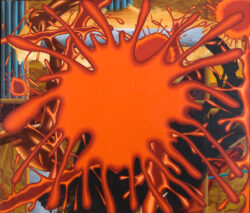Richard Johnson
Richard Johnson is often labeled an"abstract illusionist" New Orleans painter who explores classical landscapes and the figure to create highly expressionistic compositions.

Courtesy of Richard Johnson.
Richard Johnson's talent for abstract expressions of classical landscapes comes alive in "Big Red III" (2008, acrylic/collage on canvas).
Richard Johnson is often labeled as an abstract illusionist painter in New Orleans, one who explores classical landscapes and the figure to create highly expressionistic compositions. Long the master of spatial illusions, where whimsical abstract imagery seems to float across the canvas, over the years Johnson has broadened and softened his palette to include folded fabric, photographs of landscapes, works by other artists clipped from magazines, and, more recently, the human figure.
“For almost four decades, Richard Johnson has been known as New Orleans’ premier painterly magician,” wrote New Orleans art critic Doug MacCash in a February 2011 review in the New Orleans Times-Picayune. “With brushes and spray cans in hand, he produced abstract compositions that seemed to levitate off the canvas. His ever-inventive optical illusions have bent the minds of more than one generation of young artist at the University of New Orleans,” where Johnson has taught since 1978.
Born on February 26, 1942, in Minneapolis, Minnesota, Johnson received a BFA degree in 1965 from the Minneapolis College of Art and Design and a MFA from Washington University in St. Louis in 1967. That same year, he was awarded the prestigious Prix de Rome Fellowship in Painting, which enabled him to study in Rome, Italy, for a year. He also received a Rockefeller Foundation Grant in 1981. In 1986, the Contemporary Arts Center in New Orleans named him Artist of the Year. In 1993, he received a fellowship at the Virginia Center for Creative Arts in Amhurst, Virginia, and in 2003, the New Orleans Museum of Art’s Delgado Society proclaimed him Artist of the Year.
Like many young artists in the 1960s, Johnson’s work and thoughts about art were heavily influenced by the then emerging New York School and artists such as Robert Motherwell, Willem DeKooning, and Franz Kline, who were exploring new directions in the visual arts. Throughout his adult life, Johnson has pursued dual careers as a working artist and teacher. His first faculty position was at East Texas State University in Commerce from 1968 to 1972, followed by Indiana University in Bloomington from 1972 to 1975, and finally at the University of New Orleans (UNO) from 1978 to present. At UNO, he served as chair of the fine arts department from 1978 to 1981 and from that year to the present as professor of fine arts.
In a December 2011 artist statement, Johnson described his work’s most-recent evolution: “In the mid to late nineties, I became somewhat restless with the art I was making. I had become less motivated with pure abstraction. It occurred to me that I would have to move in another direction and bring something new to the work. At first I began integrating the figure and various other images I had collected from magazines and collage them into my paintings without totally abandoning the abstract. In my first exhibition at Cole Pratt Gallery [New Orleans] in 2005, the female figure was apparent in many of the paintings but in a more subtle and secondary way. As I worked through this process my work became more centered on the prominence of the female figure.”
Johnson has enjoyed considerable success with one-artist shows in Rome; New York City; Dallas, Texas; Houston, Texas; Chicago, Illinois; Atlanta, Georgia; Los Angeles, California; New Orleans; and New London, Connecticut. His paintings have been included in shows at such museums as the New Orleans Museum of Art; the Denver Museum of Art in Colorado; the Dallas Museum of Art in Texas; and the Southeastern Center for Contemporary Art in Winston-Salem, North Carolina.
Johnson’s work can be found in numerous public and private collection, such as the Morris Museum of Art in Augusta, Georgia; the New Orleans Museum of Art; the Pensacola Museum of Art in Florida; Tulane University Law School in New Orleans; the Birmingham Museum of Art in Alabama; the Figge Art Museum in Davenport, Iowa; the British Museum in London, England; the Alexandria Museum of Art in Louisiana; the Equitable Life Insurance Society in New York City; Phillip Morris Inc. in New York City; and the Ogden Museum of Southern Art in New Orleans.
